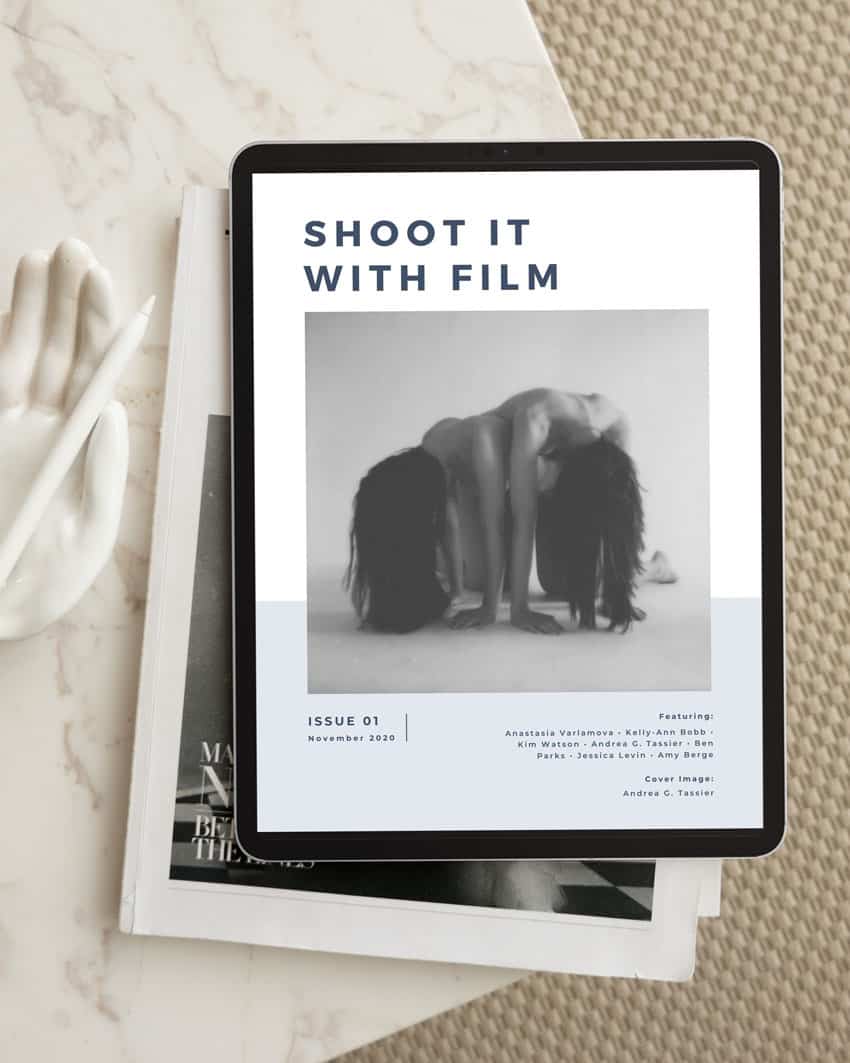
Written by Katya Rowny
My first medium format camera was the Yashica-D. I remember the day it arrived in the mail as a gift from a family friend.
I opened the box slowly, unpackaging the hefty camera with care. I was awed by the beauty and craftsmanship of the camera and also felt intimidated by the Twin Lens Reflex system. I wasn’t familiar with a TLR, or medium format for that matter.
So, unfortunately, my beautiful, new-to-me Yashica-D sat on my shelf for a few months while I researched and gathered up the courage to try shooting on it.
Find the Yashica-D at KEH Camera or on eBay.

History of the Yashica-D
The first Twin Lens Reflex (TLR) camera from Yashica (Yashima Optical Co. Ltd.) was the Pigeonflex in the early 1950s. Following the release of this camera, a series of “flex” cameras followed, such as the Yashimaflex, Minoltaflex, Olympusflex, and Richoflex.
Apparently, thinking the word Yashima sounded too Japanese for the foreign market, they combined the words Yashima and camera to make the word Yashica. Following a series of small yet significant upgrades to the camera over the years
There was a series of Yashica TLR’s that were made during their production run from the 1950s to 1972. Some of them include the Yashica A, Yashica LM, Yashica 635 (which has an adapter kit to use both 35mm and 120 film), and the famous Yashica Mat 124g (which boasts gold-plated contacts).
There are a multitude of “different” yet similar Yashica TLRs made during their production run, with some being targeted for foreign markets and never reaching US shores.
Initially, the taking lens was a Tomioka Tri-Lausar beginning with the Pigeonflex, slowly evolving to a Yashikor 80mm 3.5 and ending with the Yashinon 80mm 3.5 lens.



Upgrades on the Yashica-D
The Yashica-D serves as the pinnacle of the knob-wind models, incorporating many of the upgrades found in the Yashica-Mat.
These include Rollei-esque shutter speed and aperture control wheels, Bay 1 filter mounts, a Copal-MXV shutter, offering speeds ranging from 1 to 1/500 seconds, and an integrated frame counter.
My Yashica-D is an earlier model because it is equipped with the coated three-element Yashikor 80mm f/3.5 viewing and the 3.5 taking lens with the Copal MXV shutter.
In the later years of TLR production, Yashica enhanced the taking lens by upgrading from a 3-element Yashikor to a 4-element Yashinon. While both lenses had an aperture of f/3.5, the Yashikor was impressive.
The viewing lens was also upgraded to a f/2.8 Yashinon. The larger aperture meant that more light could enter the viewfinder to increase the overall brightness.


Technical Specs
Film Type: 120 film with 12 6cm x 6cm exposures per roll
Taking Lens: 80mm f/3.5 Yashinon coated 4-elements
Viewing Lens: 80mm f/2.8 Yashinon coated 4-elements
Focus: 3.3′ (1m) to infinity
Viewfinder: Coupled Reflex Viewfinder
Shutter: Copal MXV Leaf
Shutter Speeds: B, 1 – 1/500 seconds
Exposure Meter: None
Battery: None
Flash Mount: PC M – X Sync
Manual: link to PDF manual


Using the Yashica TLR
Once I finally got up my courage, I sat down to learn how to shoot with the Yashica.
Operating the camera follows the standard procedure for TLRs. Yashica employs a convenient system utilizing two circular knobs in the middle of the lenses for adjusting shutter speed and aperture when composing your frame.
A small window positioned above the viewing lens and facing the sky displays the chosen settings. This makes it easier to see your settings when composing your shot and looking down into the viewfinder.
The film advance knob automatically locks when it reaches the next frame, and the shutter needs to be cocked before taking a shot. There are some models that do not have the locking knob and have unintentionally shot multiple exposures before advancing to the next frame.


Loading Film
Loading the film on a medium format TLR can be overwhelming at first (it was for me), but don’t worry, you’ll get the hang of it in no time.
You will have to put your camera face down to load the film. First, you will want to unscrew the bottom wheel to “O” for open.
Next, put the empty spool at the top takeup slot. Then, placing the film at the bottom, draw out the film leader, and insert it into the takeup spool.
Now, wind the film until the large arrow aligns with the red triangles on the camera. Close and lock the back of the camera, then turn the wind knob until the “S” changes to “1.” The camera will automatically lock onto the next frame after each shot and wind on.


Focusing
If you’re new to using a TLR, focusing can be challenging initially. The waist-level finder requires you to look down to focus, making it difficult to shoot photos above chest level.
Additionally, the image in the viewfinder is horizontally reversed, adding to the confusion.
However, the large focusing screen provides a delightful viewing experience, and there’s a magnifying loupe for detailed adjustments along with the sports finder for swift captures. It should be noted to be careful when using the sports finder because improperly folding could cause damage to the magnifying loupe.
In the owner’s manual, there is a warning about changing shutter speeds after cocking the shutter and potentially causing damage to the leaf shutter. Another warning from the manufacturer involves the self-timer and shutter. See below:
“WARNING: The Copal-MXV shutter on the Yashica-D absolutely will not allow the self-timer to work with the flash sync lever in the ‘M’ position. It must be in the ‘X’ position or you will damage the camera requiring it to be serviced. There is a mechanical lockout which is designed to prevent you from doing this, but some people may try forcing it, which will damage the shutter. This isn’t an internet perpetuated urban legend, the original Yashica-D user’s manual specifically tells you this. So seriously, don’t try it. If you encounter a non-working Yashica-D, it is highly likely because of this very reason.”
– Mike Eckman Blog
The leaf shutter operates quietly, though, making it ideal for capturing candid moments.


Related: Yashica Mat-124G Camera Review
Parallax Error
One drawback of the camera stems from its twin-lens system. With one lens for viewing and the other for capturing, there’s a risk of parallax error, particularly noticeable when photographing objects at close range.
Parallax error is when the image captured through the lens is different from what you see through the viewfinder.
This discrepancy can result in unintentionally cutting out parts of the scene in the final image. I find myself regularly cropping and straightening after getting my scans back due to my images being off kilter.


Using the Yashica-D for Portraits and Street Photography
The Yashica-D is particularly well-suited for portrait photography and street photography. You may even find yourself feeling like Vivian Maier, who shot with a Rolleiflex TLR.
Its downward-facing design allows for inconspicuous shooting, and the focusing screen remains visible when the shutter is pressed, unlike SLR cameras.
Inside the viewfinder, a Fresnel screen has several vertical and horizontal gridlines to aid in leveling and composing your shots.
If you feel inclined to upgrade the ground glass of the camera to a different style or better quality, you can do so here for around $100 plus shipping. There are a handful of other accessories that can make shooting your TLR fun, such as a lens hood, cable release, filters, and a flash gun.


Final Thoughts
If one of these Yashica cameras comes across your radar, I highly recommend getting one. The Yashica-D is such a joy to shoot and a conversation starter when out and about.
The image quality is superb for such an old camera, and because it’s been around for so many years, there are numerous resources online for troubleshooting.
Also, because Yashica made so many various similar models, the last one the Yashica Mat 124G (ceased production in 1986), doing any required repairs is possible if issues arise.


Thank you so much, Katya! Katya is a regular contributor for Shoot It With Film, and you can check out her other articles here, such as the Nikon One Touch L35AF2 Film Camera Review and Learn to Shoot Film: 5 Tips to Get You Started.
You can also find more of Katya’s work on her website and Instagram.
Leave your questions about the Yashica-D TLR medium format film camera below in the comments, and you can pick one up for yourself at KEH Camera or on eBay.








Blog Comments
Karin
May 3, 2024 at 11:23 am
those are really beautiful results, and I love your motifs and compositions
Katya
May 4, 2024 at 3:15 pm
Hi!
Thanks so much 🙂
DeWayne Carver
May 4, 2024 at 5:58 pm
Great article and great pictures! I owned one of those Yashica Mat124G TLRs for a while, and found it very sharp and significantly lighter-weight than the Rolleiflex. Most of what you said about your camera is applicable to that one, too. I gave mine away to a young person who was starting film photography. I hope that person can read your article someday!
Katya
May 6, 2024 at 4:50 pm
Thank you so much for the kind words! What a kind gesture to give your camera away to a young budding photographer. May we all have a helping hand when starting a new adventure : )
Curtis Heikkinen
May 14, 2024 at 9:58 am
Your article helped inspire me to order one of these cameras from KEH, one with an 80mm F3.5 Yashikor. Supposed to be in excellent condition. I look forward to learning how to use it. Your article will be consulted a lot I suspect. Great article!
Curtis Heikkinen
May 14, 2024 at 1:56 pm
I have a question also. What camera strap do you use with this camera? Thanks!
Katya
May 14, 2024 at 7:24 pm
Hi Curtis! Thanks so much for positive feedback. I’m so excited for you to use your Yashica D when it arrives! As for the strap I use a vintage one that I acquired a while ago. I like it because it’s very wide and helps with balancing the heavy camera. I suspect you could find a bundle of vintage straps on eBay…
Hope you enjoy the camera!!
Curtis Heikkinen
June 3, 2024 at 9:33 am
Hi again! I am happy to report that I am loving my Yashica D. I have an additional question. How difficult is it to install the Bright Screen focusing screens? Do they significantly help with focusing which can be challenging on this camera? Thanks!
Katya
June 3, 2024 at 2:59 pm
Hi!
I’m so happy to hear that you love your camera! Unfortunately, I’ve never replaced my ground glass but i believe it would be worth it if you are willing to spend the extra money to ship it or do it yourself. 🙂 I’m sure there are tutorials on YouTube that might help you decide which route to take. Check out Rick Olsen’s website – Bright Screens (dot) com.
Happy shooting 🙂